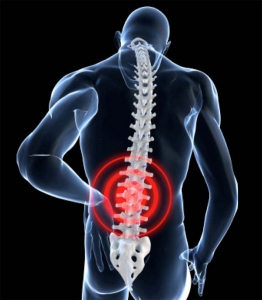 Low back pain is a ubiquitous disorder that will affect most human beings with at least one disabling episode in their lifetime. In the United States, low back pain is the second most common reason for evaluation by a physician after cold. Fortunately, usually back pain will be self-limiting and will spontaneously recover. Studies suggest that back pain will improve such that the majority of patients will return to their previous level of function within four weeks of onset of their disabling low back pain.
Low back pain is a ubiquitous disorder that will affect most human beings with at least one disabling episode in their lifetime. In the United States, low back pain is the second most common reason for evaluation by a physician after cold. Fortunately, usually back pain will be self-limiting and will spontaneously recover. Studies suggest that back pain will improve such that the majority of patients will return to their previous level of function within four weeks of onset of their disabling low back pain.
Within three months, over 90% of patients will be capable of their usual level of function. More recent studies suggest that despite returning to their previous level of function, patients will have some persistent symptoms for which they will continue to seek treatment or self-treat with activity modification and over-the-counter medications.
There are certain “yellow” and “red” flags, which may raise a physician’s concern.
When the symptoms remain relatively severe or disabling, a patient will frequently seek medical treatment for their low back pain. When evaluated, certain conditions need to be ruled out including cancer, infection, or fracture. These conditions are relatively rare and can usually be ruled out with a clinical interview and examination. There are certain “yellow” and “red” flags, which may raise a physician’s concern regarding more serious conditions and necessitating other diagnostic testing such as x-ray, CT or MRI scan. However, in the vast majority of cases, the low back pain does not need to be assessed with these frequently performed imaging studies. MRI scans in most asymptomatic individuals over the age of 30 years old without low back pain will demonstrate abnormalities. Therefore, the presence of MRI abnormalities in a patient with low back pain does not indicate that those abnormalities are the cause of the low back pain. If there are no medical indications for these imaging studies, the positive findings on the imaging studies may lead to unnecessary care or other testing.
If your low back pain persists or is disabling, evaluation by a trained specialist is recommended.
If you were to suffer an episode of low back pain unrelated to significant trauma, it is suggested that you minimize your bed rest to 48 hours or less, maintain your usual activity level as tolerated, take over-the-counter pain relieving medications, and apply ice or heat as needed. However, if your low back pain persists or disabling despite these first-aid measures, evaluation by a trained specialist would be most appropriate.
Contact Dr Scott Naftulin and Specialty Spine Care for an evaluation appointment.

